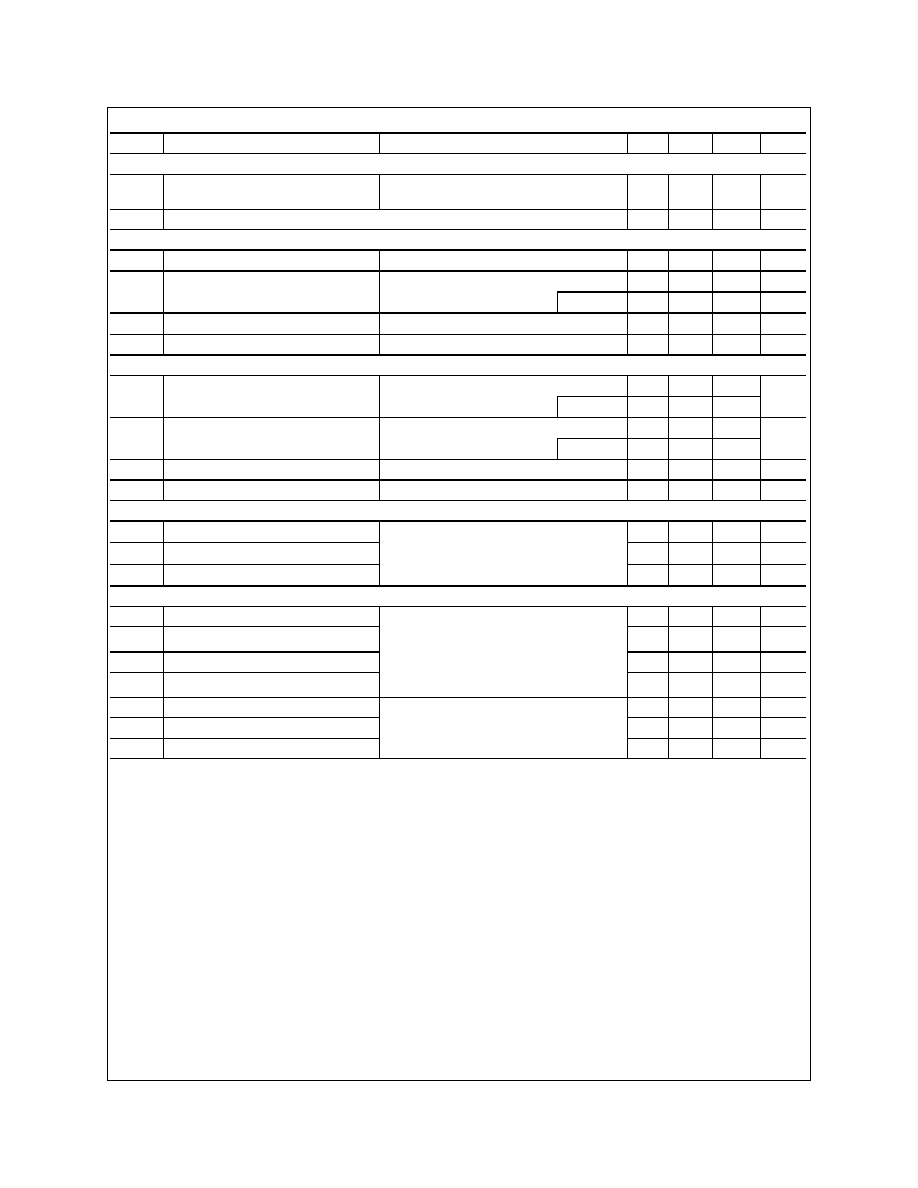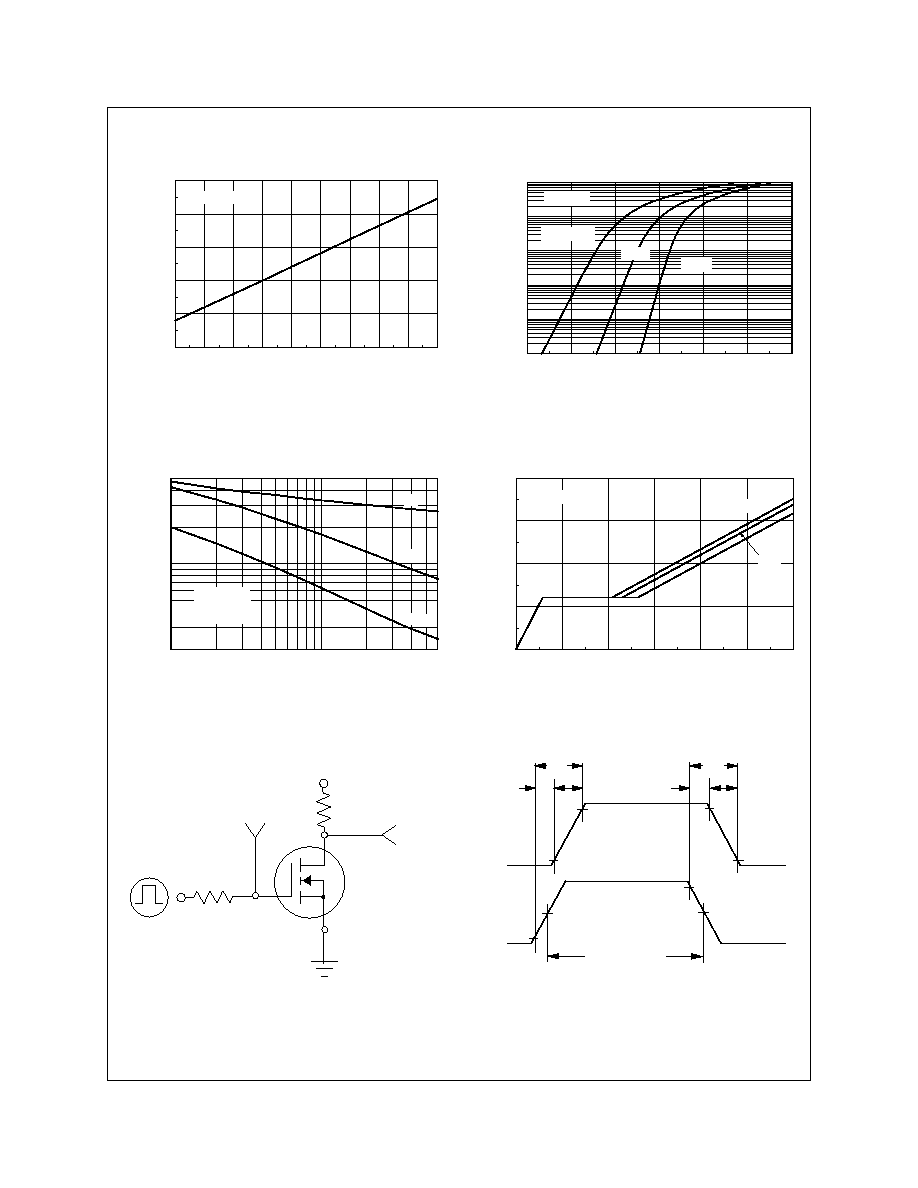 | –≠–ª–µ–∫—Ç—Ä–æ–Ω–Ω—ã–π –∫–æ–º–ø–æ–Ω–µ–Ω—Ç: NDB7050 | –°–∫–∞—á–∞—Ç—å:  PDF PDF  ZIP ZIP |

March 1996
NDP7050 / NDB7050
N-Channel Enhancement Mode Field Effect Transistor
General Description
Features
_______________________________________________________________________________
Absolute Maximum Ratings
T
C
= 25∞C unless otherwise noted
Symbol
Parameter
NDP7050
NDB7050
Units
V
DSS
Drain-Source Voltage
50
V
V
DGR
Drain-Gate Voltage (R
GS
< 1 M
)
50
V
V
GSS
Gate-Source Voltage - Continuous
± 20
V
- Nonrepetitive (t
P
< 50 µs)
± 40
I
D
Drain Current
- Continuous
75
A
- Pulsed
225
P
D
Maximum Power Dissipation @ T
C
= 25
∞
C
150
W
Derate above 25
∞
C
1
W/
∞
C
T
J
,T
STG
Operating and Storage Temperature Range
-65 to 175
∞C
T
L
Maximum lead temperature for soldering
purposes, 1/8" from case for 5 seconds
275
∞C
NDP7050.SAM Rev. D
These N-Channel enhancement mode power field effect
transistors are produced using Fairchild's proprietary, high
cell density, DMOS technology. This very high density
process is especially tailored to minimize on-state
resistance, provide superior switching performance, and
withstand high energy pulses in the avalanche and
commutation modes. These devices are particularly suited
for low voltage applications such as automotive, DC/DC
converters, PWM motor controls, and other battery powered
circuits where fast switching, low in-line power loss, and
resistance to transients are needed.
75A, 50V. R
DS(ON)
= 0.013
@ V
GS
=10V.
Critical DC electrical parameters specified at elevated
temperature.
Rugged internal source-drain diode can eliminate the need
for an external Zener diode transient suppressor.
175∞C maximum junction temperature rating.
High density cell design for extremely low R
DS(ON)
.
TO-220 and TO-263 (D
2
PAK) package for both through
hole and surface mount applications.
S
D
G
© 1997 Fairchild Semiconductor Corporation

Electrical Characteristics
(T
C
= 25∞C unless otherwise noted)
Symbol
Parameter
Conditions
Min
Typ
Max
Units
DRAIN-SOURCE AVALANCHE RATINGS
(Note 1)
W
DSS
Single Pulse Drain-Source Avalanche
Energy
V
DD
= 25 V, I
D
= 75 A
550
mJ
I
AR
Maximum Drain-Source Avalanche Current
75
A
OFF CHARACTERISTICS
BV
DSS
Drain-Source Breakdown Voltage
V
GS
= 0 V, I
D
= 250 µA
50
V
I
DSS
Zero Gate Voltage Drain Current
V
DS
= 50 V, V
GS
= 0 V
250
µA
T
J
= 125∞C
1
mA
I
GSSF
Gate - Body Leakage, Forward
V
GS
= 20 V, V
DS
= 0 V
100
nA
I
GSSR
Gate - Body Leakage, Reverse
V
GS
= -20 V, V
DS
= 0 V
-100
nA
ON CHARACTERISTICS
(Note 1)
V
GS(th)
Gate Threshold Voltage
V
DS
= V
GS
, I
D
= 250 µA
2
2.8
4
V
T
J
= 125∞C
1.4
2.1
3.6
R
DS(ON)
Static Drain-Source On-Resistance
V
GS
= 10 V, I
D
= 40 A
0.01
0.013
T
J
= 125∞C
0.015
0.023
I
D(on)
On-State Drain Current
V
GS
= 10 V, V
DS
= 10 V
75
A
g
FS
Forward Transconductance
V
DS
= 10 V, I
D
= 37.5 A
15
39
S
DYNAMIC CHARACTERISTICS
C
iss
Input Capacitance
V
DS
= 25 V, V
GS
= 0 V,
f = 1.0 MHz
2960
3600
pF
C
oss
Output Capacitance
1130
1600
pF
C
rss
Reverse Transfer Capacitance
380
800
pF
SWITCHING CHARACTERISTICS
(Note 1)
t
D(on)
Turn - On Delay Time
V
DD
= 30 V, I
D
= 75 A,
V
GS
= 10 V, R
GEN
= 5
17
30
nS
t
r
Turn - On Rise Time
128
400
nS
t
D(off)
Turn - Off Delay Time
54
80
nS
t
f
Turn - Off Fall Time
90
200
nS
Q
g
Total Gate Charge
V
DS
= 48 V,
I
D
= 75 A, V
GS
= 10 V
100
115
nC
Q
gs
Gate-Source Charge
14.5
nC
Q
gd
Gate-Drain Charge
51
nC
NDP7050.SAM Rev. D

Electrical Characteristics
(T
C
= 25∞C unless otherwise noted)
Symbol
Parameter
Conditions
Min
Typ
Max
Units
DRAIN-SOURCE DIODE CHARACTERISTICS
I
S
Maximum Continuos Drain-Source Diode Forward Current
75
A
I
SM
Maximum Pulsed Drain-Source Diode Forward Current
225
A
V
SD
Drain-Source Diode Forward Voltage
V
GS
= 0 V, I
S
= 37.5 A
(
Note 1)
0.9
1.3
V
T
J
= 125∞C
0.84
1.2
t
rr
Reverse Recovery Time
V
GS
= 0 V, I
F
= 75 A, dI
F
/dt = 100 A/µs
80
150
ns
I
rr
Reverse Recovery Current
2
4.8
10
A
THERMAL CHARACTERISTICS
R
JC
Thermal Resistance, Junction-to-Case
1
∞
C/W
R
JA
Thermal Resistance, Junction-to-Ambient
62.5
∞
C/W
Note:
1. Pulse Test: Pulse Width < 300 µs, Duty Cycle < 2.0%.
NDP7050.SAM Rev. D

NDP7050.SAM Rev. D
-5 0
-25
0
2 5
5 0
7 5
1 0 0
1 2 5
1 5 0
1 7 5
0 .4
0 .6
0 .8
1
1 .2
1 .4
1 .6
1 .8
2
T , JUNCTION TEM PERA T U RE (∞C)
DRAIN-SOURCE ON-RESISTANCE
J
V = 10V
GS
I = 40A
D
R , NORMALIZED
DS(ON)
-5 0
-25
0
25
5 0
75
1 0 0
1 2 5
1 5 0
1 7 5
0 .5
0 .6
0 .7
0 .8
0 .9
1
1 .1
1 .2
T , JUNCTION TEM PERATURE (∞C)
GAT
E-SO
URCE THRESHOLD VOLTAGE
J
V , NOR
MAL
IZED
GS(th)
I = 2 5 0 µ A
D
V = V
GS
DS
0
2 0
4 0
6 0
8 0
1 0 0
1 2 0
0 .5
1
1 .5
2
2 .5
I , DRA IN CURRENT (A)
DRAIN-SOURCE ON-RESISTANCE
V = 5 .0 V
GS
D
R ,
NORMALIZED
DS(on)
5.5
8.0
7.0
6.5
6 .0
1 0
2 0
1 2
0
2 0
4 0
6 0
8 0
1 0 0
1 2 0
0 .6
0 .8
1
1 .2
1 .4
1 .6
1 .8
I , DRAIN CURRENT (A)
DR
A
IN-SOURCE ON-RESISTANCE
T = 125∞C
J
2 5 ∞ C
-5 5 ∞ C
D
V = 10V
GS
R ,
NO
RMALIZED
DS(on)
2
3
4
5
6
7
0
10
20
30
40
50
60
V , GATE TO SOURCE VOLTAGE (V)
I , DR
A
IN CURRENT (A)
2 5 ∞ C
1 2 5 ∞ C
V = 1 0 V
DS
GS
D
T = -55∞C
J
Typical Electrical Characteristics
Figure 1. On-Region Characteristics
.
Figure 2. On-Resistance Variation with Gate
Voltage and Drain Current.
Figure 3. On-Resistance Variation
with Temperature.
Figure 4. On-Resistance Variation with Drain
Current and Temperature.
Figure 5. Transfer Characteristics
.
Figure 6. Gate Threshold Variation with
Temperature
.
0
1
2
3
4
5
0
2 0
4 0
6 0
8 0
1 0 0
1 2 0
V , DRAIN-SOURCE VOLTAGE (V)
I , DR
A
IN-SOURCE CURRENT (A)
8 .0
V = 2 0 V
GS
DS
D
5 .5
6 .0
6 .5
7 .0
4 .0
4 .5
5 .0
1 0

NDP7050.SAM Rev. D
-50
-25
0
2 5
5 0
7 5
1 0 0
1 2 5
1 5 0
1 7 5
0 .9
0 .9 5
1
1 .0 5
1 .1
1 .1 5
T , JUNCTION TEM PERA T U RE (∞C)
DRAIN-SOURCE BREAKDO
WN VOLTAG
E
I = 250µA
D
BV , NORMALIZED
DSS
J
0 .2
0 .4
0 .6
0 .8
1
1 .2
1 .4
0 .001
0 .01
0 .1
1
1 0
5 0
1 0 0
V , BODY DIODE FORW A RD VOLTAGE (V)
I , REVERSE DRAIN CURRENT (
A
)
V = 0V
GS
T = 1 2 5 ∞ C
J
25∞C
-5 5 ∞ C
SD
S
0
2 5
5 0
7 5
1 0 0
1 2 5
1 5 0
0
5
1 0
1 5
2 0
Q , GATE CHARGE (nC)
V , GAT
E-SO
URCE VOLTAGE (V)
g
GS
4 8 V
I = 7 5 A
D
V = 1 2 V
DS
2 4 V
1
2
5
1 0
2 0
3 0
6 0
2 0 0
3 0 0
5 0 0
1 0 0 0
2 0 0 0
3 0 0 0
5 0 0 0
V , DRAIN TO SOURCE VOLTAGE (V)
CAPACITANCE (pF)
DS
f = 1 M H z
V = 0V
GS
C
oss
C
iss
C
rss
G
D
S
V
DD
R
L
V
V
IN
OUT
V
GS
DUT
R
GEN
1 0 %
5 0 %
9 0 %
1 0 %
9 0 %
9 0 %
5 0 %
V
IN
V
OUT
o n
off
d (off)
f
r
d (o n )
t
t
t
t
t
t
INVERTED
1 0 %
PULSE WIDTH
Figure 7. Breakdown Voltage Variation with
Temperature.
Figure 8. Body Diode Forward Voltage
Variation with Current and Temperature.
Figure 9. Capacitance Characteristics.
Figure 10. Gate Charge Characteristics.
Figure 11. Switching Test Circuit
.
Figure 12. Switching Waveforms
.
Typical Electrical Characteristics
(continued)




